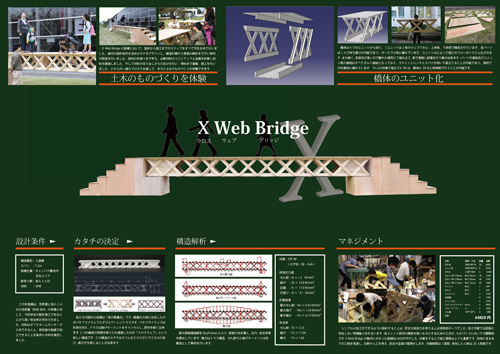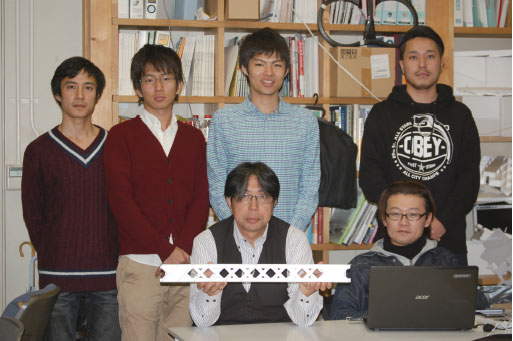| Introduction |
|
Use of BIM (Building Information Modeling) is increasing widely in construction
projects worldwide. "CIM (Construction Information Modeling (/ Management))"
is a way of applying the method of BIM to the fi eld of developing infrastructure,
using ICT (Information Communication Technology) to the fullest over the
whole life cycle of a public project. It is intended to bring about improved
productivity as a whole construction project by introducing threedimensional
(3D) models that encompasses different kinds of property information within
3D geometry information from an early phase of a project, linking and extending
related pieces of information throughout a series of processes. On the
other hand, since Ministry of Land, Infrastructure, Transport, and Tourism
(MLIT) presented its policy to examine introduction of CIM, those involved
have drawn different images about the concept of CIM according to their
difference in viewpoints. However, through efforts in CIM technology study
sessions led by the private sector and CIM system study sessions led by
the government, various attempts by cooperation among industry, government,
and academia, and accumulation of utilization of BIM by private companies,
concepts of CIM and its technical challenges as well as the image of its
specifi c use are now being gradually organized.
In this context, we start a series in aiming at helping to have CIM more
understood and get spread. We will interview key persons in different fi
elds who are working on CIM in an advanced way for its utilization as well
as development and research of related technologies. Possibilities of CIM
and its challenges, and future directions will be featured. |
|
Actively Using Software of Modeling and VR in the Lab
A specialist in studying structures including bridges and designing public
spaces such as parks, roads, and rivers, Prof. Seki wants to tell joy of
"manufacturing things", hardship of creating them on the contrary,
and the sense of accomplishment beyond the hardship to students through
them--- that's what he Prof. Seki aims at in his Structure and Design Lab
where he teaches. In the lab, particular emphasis were put on the following
4 events in this year:
1) Creation of "X (Cross) Web Bridge", a bridge on which people
can walk over,
2) Repairing an masonry irrigation channel that has been used over 4 00
years ( Kanra cho, Gunma) with dry stone fi ll,
3) Participation in Virtual Design World Cup (VDWC) sponsored by FORUM8,
and
4) Job experience in a foreign country (a structure fi rm in Hong Kong).
Regarding creation of a bridge, students design according to design conditions, make structural analysis, select materials, and process them. They are transported from Surugadai campus to Funabashi campus to build up. Then the bridge is to be presented at the college festival for visitors to cross. Students are to experience practical use of the modeling software, too.
Participation in VR competition (VDWC) aims at helping students develop
ability to predict future. In the process, students do research and make
analysis, and work out concepts. After fi nishing the design, they create
a concept poster. Like this, he attaches great importance to this as this
off ers an opportunity of not only learning techniques for using VR software
but also eff ective training to understand the whole process fl ow.
 |
Professor Fumio Seki, Department of Civil Engineering,
College of Science and Technology, Nihon University |
Progress in Involvement with CIM-related Technologies Such as 3D Modeling
"20 and more years ago, I worked about 2 years on development of an
'automatic calculation program for PC bridges', which allows automatic
calculation of stress etc. with 3D models created by 3D arrangement of
PC wires." Prof. Seki looks back his early activities related with
CIM when he was working for a general contractor.
However, he faced with difficulty of allotting coordinates or modeling on 3D basis for a drawing that were entirely created on 2D basis. When inputting data in an interactive way, it was hard to input by making the design fl ow of that time into a sheet as it was. He came to the conclusion that new 3D modeling software was needed to overcome the problem. So that time it wasn't put to practical use.
At another time when attempting to make a working drawing from the detailed
design, there occurred some inconsistency depending on arrangement of combined
wires. It took an enormous amount of time and trouble if modifying the
part more precise than needed. That made him realize difficulty of making
it to practical use. He recognized that appropriate roughness with some
speed is required for business practice.
Moreover, when he took part in construction of the Ashigara Bridge on Tomei
Expressway, in order to capture the part where diagonal members touch the
noise barrier depending on the alignment of a cable stayed bridge; he made
examination with 3D software by himself using models created by outsourcing.
Through these experiences, he came to know FORUM8's 3D real-time VR "UC-win/Road",
which was still under development. He got interested in it.
Assumed Restrictions and Expected Uses of Data Sharing
After that his job shifted to design. Along with this, he realized the
actual situation that broadly there were gaps among 3 steps of "from
proposal to planning, design, and presentation", "structural
calculation and detailed design", and "construction". In
addition, unlike architecture there are many kinds of objects to manufacture
in civil engineering. So even if data can be used as it is in civil engineering,
there might be a problem when it comes to the precision of treating reinforced
concrete and PC (prestressed concrete). Depending on the case, data sharing
beyond the gap mentioned above (for example between design and construction)
might cause errors after another. Or if you try to connect from design
to the full-scale structural calculation, big difference in the precision
would cause another process of refining shape. These led to the assumption
that it would be hard to put it to practical use.
Regarding this, Prof. Seki mentioned the project he had experienced overseas.
Giving priority to the timeframe of just 2-3 weeks before presentation,
data sharing was not made, but he performed several
works such as creation of CG, structural calculation, and integration in
parallel based on CAD data of the outline base model. Finishing rendering
covered problems of CG caused by roughness of the original data. He expects
part of advantages that can be brought about by CIM, saying that CIM should
display its power in showing the structural analysis by data sharing through
"planning to design" and modeling, reflecting it in VR and visualizing
the completed space.
 |
| X Web Bridge (image provided by Prof. Fumio Seki) |
Expectation towards Utilization of CIM and Challenges; "Produce"
Function Is Focused
Prof. Seki says that it is attraction of CIM to be able to multiple tasks at the same time, that is, "capability of making presentation of planning to design using modeling software".
In this point he pays attention to the importance of a function to "produce"
during the process related with presentation. In such a case, it is required
to properly understand not only the project itself but also related technologies
and the owner's purpose, with a team organized by experts of different
fields. Then it is needed to propose to the owner apt precision of VR etc.
for presentation according to the individual situation.
If such use can be realized with ease, quality of design will be improved
and broadly speaking, manufacturing in Japan will change. However, he says
that in order for this to realize, it will also be necessary to standardize
modeling to some extent towards data sharing, improve the order system
of public work projects to help enhancement of technologies of enterprises,
and reform the business model of the construction industry by reflecting
them. On the other hand, unlike BIM in the architectural field, targets
of civil engineering to which CIM is applied vary a lot.
"(For this reason,) I think we should not try to do everything to
the end (with CIM) but explore how far it can be used, testing in different
ways with flexible mind."
 |
| "Structure and Design Laboratory" |
(Written by Takashi Ikeno)
|


